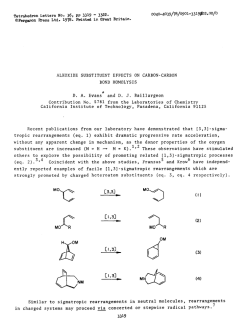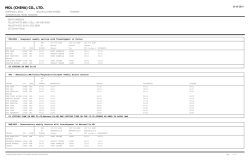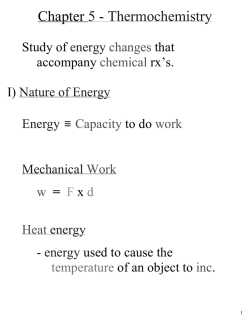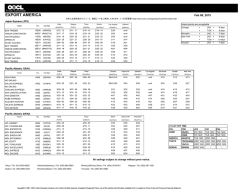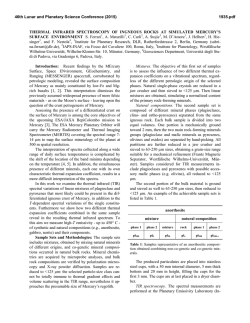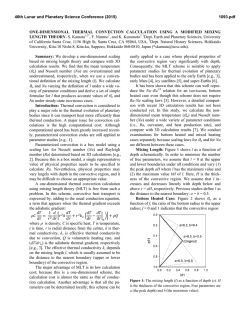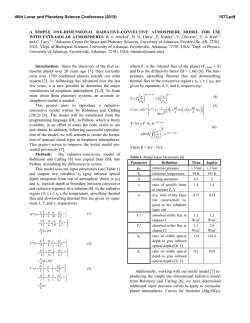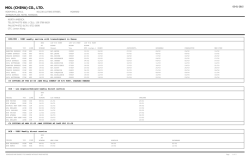
Chem12 SM Ch05 Section5 2 final ok revised
Section 5.2: Calorimetry and Enthalpy
Tutorial 1 Practice, page 297
1. Given: VH 2O(l) = 6.0 mL ; Tinitial = 25 °C ; Tfinal = 75 °C; cH 2O(l) = 4.18 J/(g ⋅ °C) ;
d H 2O(l) = 1.00 g/mL
Required: thermal energy required, q
Analysis: q = mcΔT
Solution:
Step 1: Determine the mass of water, m.
m = Vd
1.00 g
= 6.0 mL ×
1 mL
m = 6.0 g
Step 2: Determine the change in temperature, ΔT .
ΔT = Tfinal − Tinitial
= 75 °C − 25 °C
ΔT = 50 °C
Step 3: Calculate the quantity of thermal energy, q.
q = mcΔT
⎛ 4.18 J ⎞
= (6.0 g ) ⎜
⎟ (50 °C )
⎝ g ⋅ °C ⎠
q = 1.3 kJ
Statement: The quantity of thermal energy required is 1.3 kJ.
2. Given: methylene glycol = 4.0 kg ; cethylene glycol = 3.5 J/(g ⋅ °C) ; q = 250 kJ
Required: change in temperature, ΔT
Analysis: q = mcΔT
Solution:
Step 1: Convert quantities to the appropriate units.
3
m = 4.0 kg = 4.0 × 10 g
q = 250 kJ = 250 ! 103 J
Step 2: Rearrange q = mcΔT to solve for ΔT .
q = mcΔT
q
ΔT =
mc
250 × 103 J
=
⎛ 3.5 J ⎞
(4.0 × 103 g ) ⎜
⎟
⎝ g ⋅ °C ⎠
ΔT = 18 °C
Statement: The temperature change of the solution was 18 °C.
Copyright © 2012 Nelson Education Ltd.
Chapter 5: Thermochemistry
5.2-1
3. Given: VHCl(aq) = 50.0 mL ; VNaOH(aq) = 75.0 mL ; Tinitial = 20.2 °C; Tfinal = 25.6 °C
Required: quantity of energy transferred, q
Analysis: q = mcΔT
Solution:
Step 1: Determine the total volume of HCl(aq) and NaOH(aq), V .
V = VHCl(aq) + VNaOH(aq)
= 50.0 mL + 75.0 mL
V = 125.0 mL
Step 2: Determine the total mass of two solutions , m.
Since the solution contains dilute HCl(aq) and NaOH(aq), the density and heat capacity
are assumed to be the same as those for water.
m = Vd
1.00 g
= 125.0 mL ×
1 mL
m = 125.0 g
Step 3: Determine the change in temperature, ΔT .
ΔT = Tfinal − Tinitial
= 25.6 °C − 20.2 °C
ΔT = 5.4 °C
Step 4: Calculate the quantity of energy transferred, q.
q = mcΔT
⎛ 4.18 J ⎞
= (125.0 g ) ⎜
⎟ (5.4 °C )
g
⋅
°
C
⎝
⎠
q = 2800 J
Statement: The quantity of energy transferred is 2800 J, or 2.8 kJ. Since the temperature
of the surroundings (liquid water in the calorimeter) increased, the reaction was
exothermic.
Mini Investigation: Thermal Energy Transfer in a Coffee-Cup Calorimeter,
page 297
Answers may vary. Sample answers:
mass of water in calorimeter = 100.00 g
mass of aluminum block = 89.80 g
temperature of aluminum block = temperature of hot water bath = 80.0 °C
final temperature of water in calorimeter = 27.8 °C
initial temperature of tap water = 19.8 °C
A. Given: mH 2O(l) = 100.00 g ; Tinitial = 19.8 °C ; Tfinal = 27.8 °C
Required: quantity of thermal energy gained by the water, q
Analysis: q = mcΔT
Copyright © 2012 Nelson Education Ltd.
Chapter 5: Thermochemistry
5.2-2
Solution:
Step 1: Determine the change in temperature, ΔT .
ΔT = Tfinal − Tinitial
= 27.8 °C − 19.8 °C
ΔT = 8.0 °C
Step 2: Calculate the quantity of thermal energy gained by the water, q.
q = mcΔT
⎛ 4.18 J ⎞
= (100.00 g ) ⎜
(8.0 °C )
⎜ g ⋅ °C ⎟⎟
⎝
⎠
q = 3300 J
Statement: The quantity of thermal energy gained by the water is 3300 J, or 3.3 kJ.
B. Given: mAl(s) = 89.80 g ; Tinitial = 80.0 °C ; Tfinal = 27.8 °C ; cAl(s) = 0.900 J/(g ⋅ °C)
Required: quantity of thermal energy transferred to or from aluminum, q
Analysis: q = mcΔT
Solution:
Step 1: Determine the change in temperature, ΔT .
ΔT = Tfinal − Tinitial
= 27.8 °C − 80.0 °C
ΔT = −52.2 °C
Step 2: Calculate the quantity of thermal energy transferred to or from aluminum, q.
q = mcΔT
⎛ 0.900 J ⎞
= (89.80 g ) ⎜
(−52.2 °C )
⎜ g ⋅ °C ⎟⎟
⎝
⎠
q = −4220 J
Statement: Since the value of q is negative, energy is transferred from aluminum to
water, and the quantity transferred is 4220 J, or 4.22 kJ.
C. Answers may vary. Sample answer: There is a difference of about 0.9 kJ in the
answers to A and B. The difference could be due to assumptions or experimental errors.
D. Answers may vary. Sample answer: Experimental errors include thermal energy lost to
the tongs, to the air on transfer from hot to cold water, to the thermometer, to the
calorimeter, or to the air above the water–aluminum mixture. The investigation could be
improved by taking into account the temperature changes and thus energy transferred to
the thermometer, tongs, and calorimeter. Other improvements would be increasing the
insulation of calorimeter and faster transfer from hot to cold water.
Copyright © 2012 Nelson Education Ltd.
Chapter 5: Thermochemistry
5.2-3
Tutorial 2 Practice, page 301
1. Given: mH 2O(l) = 50.0 g ; ΔH vap = 44.0 kJ/mol
Required: enthalpy change, ΔH
Analysis: ΔH = nΔH vap
Solution:
Step 1: Calculate the amount of water in 50.0 g, nH 2O(l) .
M H 2O(l) = 18.02 g/mol
mH 2O(l)
nH 2O(l) =
M H 2O(l)
=
50.0 g
18.02 g/mol
nH 2O(l) = 2.7747 mol (2 extra digits carried)
Step 2: Solve for the change in enthalpy, ΔH .
ΔH = nH 2O(l) ΔH vap
⎛ 44.0 kJ ⎞
= (2.7747 mol ) ⎜
⎟
⎝ 1 mol ⎠
ΔH = 122 kJ
Statement: The enthalpy change expected when 50.0 g of water vaporizes is 122 kJ.
2. Given: mNa 2SO4 g10H 2O(l) = 2.50 kg ; ΔH r = −78.0 kJ/mol
Required: enthalpy change, ΔH
Analysis: ΔH = nNa 2SO4 g10H 2O(l) ΔH r
Solution:
Step 1: Calculate the amount of salt in 2.50 kg, nNa SO i10H O(l) .
2
4
2
M Na SO i10H O(l) = 322.24 g/mol
2
4
2
nNa SO i10H O(l) =
2
4
2
mNa SO i10H O(l)
2
4
2
M Na SO i10H O(l)
2
4
2
3
=
2.50 ! 10 g
322.24 g/mol
nNa SO i10H O(l) = 7.7582 mol (2 extra digits carried)
2
4
2
Step 2: Solve for the change in enthalpy, ΔH .
!H = nNa SO i10H O(l) !H r
2
4
2
# "78.0 kJ &
= (7.7582 mol ) %
$ 1 mol ('
!H = "605 kJ
Statement: The change in enthalpy when 2.50 kg of Glauber’s salt enters the solid state
is –605 kJ.
Copyright © 2012 Nelson Education Ltd.
Chapter 5: Thermochemistry
5.2-4
3. Given: ΔH = 100.0 kJ ; ΔH vap = 15.7 kJ/mol
Required: mass of propane, mC3H8 (l)
Analysis: ΔH = nΔH vap
Solution:
Step 1: Rearrange ΔH = nΔH vap to solve for the amount of propane, nC3H8 (l) .
ΔH = nC3H8 (l) ΔH vap
nC3H8 (l) =
ΔH
ΔH vap
100.0 kJ
15.7 kJ /mol
nC3H8 (l) = 6.3694 mol (2 extra digits carried)
Step 2: Convert amount of propane into mass, mC3H8 (l) .
=
M C3H8 (l) = 44.11 g/mol
nC3H8 (l) =
mC3H8 (l)
M C3H8 (l)
mC3H8 (l) = nC3H8 (l) M C3H8 (l)
⎛ 44.11 g ⎞
= (6.3694 mol ) ⎜
⎟
⎝ 1 mol ⎠
mC3H8 (l) = 281 g
Statement: The mass of propane that would vaporize as a result of absorbing 100.0 kJ of
energy is 281 g.
4. Given: mNaOH(s) = 4.00 g ; VH2O(l) = 100.0 mL ; ΔT = 10.6 °C
Required: molar enthalpy of dissolution, ΔH sol
Analysis: q = mcΔT ; ΔH = nΔH sol
Solution:
Step 1: Determine the mass of water, m.
m = Vd
1.00 g
= 100.0 mL ×
1 mL
m = 100 g
Step 2: Determine the quantity of thermal energy absorbed by the water, q.
q = mcΔT
⎛ 4.18 J ⎞
= (100 g ) ⎜
⎟ (10.6 °C )
⎝ g ⋅ °C ⎠
q = 4430.8 J (2 extra digits carried)
This is the quantity of energy released, ΔH , when 4.00 g of NaOH(s) is dissolved.
Copyright © 2012 Nelson Education Ltd.
Chapter 5: Thermochemistry
5.2-5
Step 3: Convert mass of NaOH(s) into amount, nNaOH(s) .
M NaOH(s) = 40.00 g/mol
nNaOH(s) =
=
mNaOH(s)
M NaOH(s)
4.00 g
40.00 g/mol
nNaOH(s) = 0.100 mol
Step 4: Rearrange ΔH = nΔH sol to solve for the molar enthalpy of dissolution, ΔH sol .
Since energy is released, ΔH for the reaction is negative; ΔH = −4430.8 J .
ΔH = nNaOH(s) ΔH sol
ΔH sol =
ΔH
nNaOH(s)
−4430.8 J
0.100 mol
ΔH sol = −44 300 J/mol
Statement: The molar enthalpy of dissolution of sodium hydroxide is –44.3 ×103 J/mol,
or –44.3 kJ/mol.
=
Tutorial 3 Practice, page 304
1. (a) Solution:
Step 1: Write the balanced chemical equation without the energy term.
2 C2H2(g) + 5 O2(g) → 4 CO2(g) + 2 H2O(g)
Step 2: Write the balanced chemical equation for the combustion of 1 mol C2H2(g).
5
C2H2(g) + O2(g) → 2 CO2(g) + H2O(g)
2
Step 3: Since the enthalpy change has a negative value, the combustion reaction of
ethyne is exothermic. Since an exothermic reaction releases energy, place the energy term
on the right side of the equation.
5
C2H2(g) + O2(g) → 2 CO2(g) + H2O(g) + 1300 kJ
2
Copyright © 2012 Nelson Education Ltd.
Chapter 5: Thermochemistry
5.2-6
(b) Draw the reaction coordinates with the x-axis labelled “Reaction progress” and the yaxis labelled “Potential energy, Ep (kJ).” Since the reaction is exothermic, the products
will have lower potential energy than the reactants. Point the arrow from reactants
downward to products. Write the reactants on the upper left-hand side of the graph and
the products on the lower right-hand side of the graph. Include the ΔH of the reaction.
This process is combustion, so ΔH is ΔHc.
2. (a) Since the temperature of the surroundings decreases, the reaction is endothermic.
(b) Draw the reaction coordinates with the x-axis labelled “Reaction progress” and the yaxis labelled “Potential energy, Ep (kJ).” Since the reaction is endothermic, the products
will have greater potential energy than the reactants. Point the arrow from reactants
upward to products. Write the reactants on the lower left-hand side of the graph and the
products on the upper right-hand side of the graph. Include the ΔH of the reaction. This
process is dissolution, so ΔH is ΔHsol.
(c) A thermochemical equation for the reaction is:
H2O
NH4NO3(s) + 25.7 kJ ⎯⎯→
NH4NO3(aq)
3. (a) The corresponding thermochemical equation for the reaction depicted by the
potential energy diagram is: C2H5OH(l) → C2H5OH(g) ∆Hvap = 38.6 kJ
(b) The corresponding thermochemical equation for the reaction depicted by the potential
25
energy diagram is: C8H18(l) +
O2(g) → 8 CO2(g) + 9 H2O(l) ∆Hc = –5074 kJ
2
Copyright © 2012 Nelson Education Ltd.
Chapter 5: Thermochemistry
5.2-7
4. Given: [Ag + (aq)] = [Cl − (aq)] = 0.100 mol/L ; msolution = 100.0 g ; Tinitial = 22.6 °C ;
Tfinal = 23.4 °C ; c = 4.18 J/(g ⋅ °C)
Required: molar enthalpy of reaction, ΔH r
Analysis: q = mcΔT ; ΔH = nΔH r
Solution:
Step 1: Determine the change in temperature of the solution, ΔT .
ΔT = Tfinal − Tinitial
= 23.4 °C − 22.6 °C
ΔT = 0.8 °C
Step 2: Calculate the quantity of thermal energy for the reaction, q.
q = mcΔT
⎛ 4.18 J ⎞
= (100.0 g ) ⎜
⎟ (0.8 °C )
⎝ g ⋅ °C ⎠
q = 334 J (2 extra digits carried)
This is the quantity of energy released, ΔH . Since there is an increase in temperature, the
reaction is exothermic, and ΔH is negative; ΔH = −334 J .
Step 3: Determine the amount of AgCl(s) formed in the 100 mL solution, nAgCl(s) .
nAgCl(s) = nAg + (aq)
= 50.0 mL ×
0.100 mol
1000 mL
nAgCl(s) = 0.005 mol
Step 4: Rearrange ΔH = nΔH r to solve for the enthalpy of formation for 1 mol AgCl(s),
ΔH r .
ΔH = nAgCl(s) ΔH r
ΔH r =
ΔH
nAgCl(s)
−334 J
0.005 mol
ΔH r = −70 000 J/mol
Statement: The thermal energy that accompanies the formation of AgCl(s) is
–70 000 J/mol or –70 kJ/mol of AgCl(s) formed.
=
Copyright © 2012 Nelson Education Ltd.
Chapter 5: Thermochemistry
5.2-8
Section 5.2 Questions, page 306
1. Specific heat capacity is the quantity of thermal energy required to raise the
temperature of 1 g of a substance by 1 °C. The specific heat capacity of water,
4.18 J/(g·°C), is higher than that of aluminum, 0.900 J/(g·°C). When the same mass of
aluminum and water were heated to the same temperature, the water would have more
thermal energy and take longer to dissipate the excess energy, whereas aluminum would
have less thermal energy and take less time to cool down. Therefore, the aluminum foil
can be safely removed using your fingers, but touching the inside of the potato results in
a serious burn.
2. The burning of gasoline into carbon dioxide and water is a combustion reaction, which
is an exothermic process. The system releases energy and the surroundings absorb
energy. Therefore, the sign of qsystem is negative (energy released), the sign for ΔH is also
negative (exothermic process), and the sign of qsurroundings is positive (energy absorbed).
3. (a) From the balanced equation, the enthalpy change of –891 kJ is for the formation of
2 moles of water. Calculate the enthalpy change, ∆H, for 1 mole:
−891 kJ
ΔH =
2
ΔH = −446 kJ
So, the enthalpy change for each mole of water formed is –446 kJ.
(b) From the balanced equation, the enthalpy change of –891 kJ is for the formation of
1 mole of carbon dioxide. So, the enthalpy change for each mole of carbon dioxide
formed is also –891 kJ.
(c) From the balanced equation, the enthalpy change of –891 kJ is for 2 moles of oxygen
reacted. Calculate the enthalpy change, ∆H, for 1 mole:
−891 kJ
ΔH =
2
ΔH = −446 kJ
So, the enthalpy change for each mole of oxygen reacted is –446 kJ.
4. Given: mNH 4Cl(s) = 20.0 g ; ΔH sol = +14.8 kJ/mol ; VH 2O(l) = 125 mL ; ΔTinitial = 20.0 °C
Required: final temperature, ΔTfinal
Analysis: ΔH = nΔH sol ; q = mcΔT
Solution:
Step 1: Convert mass of NH4Cl(s) into amount, nNH 4Cl(s) .
M NH4Cl(s) = 53.50 g/mol
mNH 4Cl(s)
nNH 4Cl(s) =
M NH 4Cl(s)
=
20.0 g
53.50 g/mol
nNH 4Cl(s) = 0.373 83 mol (2 extra digits carried)
Copyright © 2012 Nelson Education Ltd.
Chapter 5: Thermochemistry
5.2-9
Step 2: Calculate the enthalpy change for the reaction, ΔH .
ΔH = nNH4Cl(s) ΔH sol
⎛ 14.8 kJ ⎞
= (0.373 83 mol ) ⎜
⎟
⎝ 1 mol ⎠
ΔH = 5.5327 kJ (2 extra digits carried)
Since ΔH is positive, thermal energy is absorbed from the surroundings. So, the change
in thermal energy of the surrounding water, q, is negative; q = −5.5327 kJ .
Step 3: Determine the mass of water, m.
m = Vd
1.00 g
= 125 mL ×
1 mL
m = 125 g
Step 4: Rearrange q = mcΔT to solve for the temperature change, ΔT .
q = mcΔT
q
ΔT =
mc
−5.5327 × 103 J
=
(125 g )(4.18 J ⋅ g −1 ⋅ °C −1 )
ΔT = −10.6 °C
Step 5: Calculate the final temperature, ΔTfinal .
ΔT = Tfinal − Tinitial
Tfinal = ΔT + Tinitial
= −10.6 °C + 20.0 °C
Tfinal = 9.4 °C
Statement: The final temperature observed when 20.0 g of ammonium chloride is added
to 125 mL water at 20.0 °C is 9.4 °C.
5. (a) Draw the reaction coordinates with the x-axis labelled “Reaction progress” and the
y-axis labelled “Potential energy, Ep (kJ).” Since the reaction is endothermic, the
products will have greater potential energy than the reactants. Point the arrow from
reactants upward to products. Write the reactants on the lower left-hand side of the graph
and the products on the upper right-hand side of the graph. Include the ΔH of the
reaction. This process is formation, so ΔH is ΔHf.
Copyright © 2012 Nelson Education Ltd.
Chapter 5: Thermochemistry
5.2-10
(b) Draw the reaction coordinates with the x-axis labelled “Reaction progress” and the yaxis labelled “Potential energy, Ep (kJ).” Since the reaction is exothermic, the products
will have lower potential energy than the reactants. Point the arrow from reactants
downward to products. Write the reactants on the upper left-hand side of the graph and
the products on the lower right-hand side of the graph. Include the ΔH of the reaction.
This process is combustion, so ΔH is ΔHc.
6. (a) A thermochemical equation for the combustion for propane is:
C3H8(g) + 5 O2(g) → 3 CO2(g) + 4 H2O(l) ΔH = –2220 kJ
(b) A thermochemical equation for the separation of atoms in the chlorine molecule is:
Cl2(g) → 2 Cl(g) ΔH = 243 kJ
(c) A thermochemical equation for the formation of iron(III) oxide from its elements is:
3
2 Fe(s) + O2(g) → Fe2O3(s) ΔH = –824 kJ
2
(d) A thermochemical equation for the decomposition of hydrogen chloride into its
elements is:
1
1
HCl(g) → H2(g) + Cl2(g) ΔH = 93 kJ
2
2
7. (a) A thermochemical equation for the formation of 1 mol of copper(II) chloride
from its elements is:
Cu(s) + Cl2(g) → CuCl2(s) + 220.1 kJ
(b) A thermochemical equation for the conversion of graphite to diamond is:
Cgraphite(s) + 2.0 kJ → Cdiamond(s)
(c) A thermochemical equation for the decomposition of silver chloride into its elements
is:
1
AgCl(s) + 127.1 kJ → Ag(s) + Cl2(g)
2
Copyright © 2012 Nelson Education Ltd.
Chapter 5: Thermochemistry
5.2-11
© Copyright 2025

